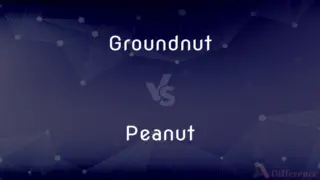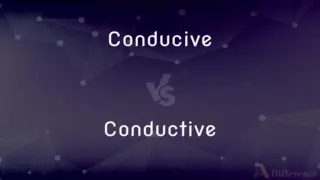Sketch vs. Diagram — What's the Difference?
By Tayyaba Rehman & Fiza Rafique — Updated on April 2, 2024
Sketches are freehand drawings focusing on quick, visual concepts, whereas diagrams are structured representations showing relationships and processes.

Difference Between Sketch and Diagram
Table of Contents
ADVERTISEMENT
Key Differences
A sketch is primarily a rapid, freehand drawing that doesn't usually adhere to scale or perfect detail, serving to quickly capture ideas, scenes, or concepts. On the other hand, a diagram is a systematic and detailed representation of ideas, objects, or processes, often created to convey complex information clearly and precisely, and usually follows specific conventions or scales.
Sketches often rely on the artist's perspective, creativity, and interpretation, making them subjective. They are used in the early stages of design to explore ideas and compositions. Whereas diagrams are objective, relying on established symbols and structures to ensure clarity and universality. They are used across various fields like science, education, engineering, and business to communicate detailed information and processes.
The tools and materials used in sketches can vary widely, from pencils and paper to digital tablets, allowing for a wide range of textures and effects. Diagrams, however, often require more precise tools and software, such as CAD programs or graphic design software, to ensure accuracy and adherence to standards.
Sketches are characterized by their immediacy and spontaneity, capturing the essence or a fleeting moment of the subject matter. They can be abstract or realistic but are generally not burdened with the need for precision. Diagrams, in contrast, are planned and deliberate, often the result of thorough analysis and designed to communicate specific information or to solve problems systematically.
While sketches provide a personal, interpretative view of the world, diagrams aim to offer a universal, decipherable code that communicates specific information irrespective of the viewer's personal perspective. This distinction makes sketches more suitable for artistic exploration and initial design phases, whereas diagrams are indispensable for instruction, explanation, and detailed planning.
ADVERTISEMENT
Comparison Chart
Purpose
To quickly capture and convey ideas or concepts.
To clearly show relationships or processes.
Precision
Low to medium; not necessarily to scale.
High; often requires precise measurements and scales.
Creativity
High; depends on the artist’s style and intention.
Lower; focuses on clarity and universality of information.
Usage
Early stages of design, art, and conceptualization.
Instruction, analysis, and communication of specific information.
Representation
Subjective and interpretative.
Objective and systematic.
Compare with Definitions
Sketch
An imaginative or creative piece of work.
The artist’s sketch captured the mood of the city at night.
Diagram
A schematic representation of a system.
The presentation used diagrams to explain the software architecture.
Sketch
A quick, informal drawing.
The designer created a sketch of the dress to brainstorm ideas.
Diagram
A figure composed of lines that is used to illustrate a definition or statement or to aid in the proof of a proposition.
The geometry textbook contained diagrams to explain each theorem.
Sketch
A rough drawing representing the main features.
She drew a sketch of the new garden layout.
Diagram
A chart or plan that outlines and explains the parts or operation of something.
The engineer created a diagram to show the circuitry.
Sketch
A preliminary form of any writing, work of art, or design.
The architect presented a sketch of the building’s facade.
Diagram
A graphical representation of data or processes.
The report featured a diagram illustrating the project’s timelines.
Sketch
A basic outline or version of something.
The writer jotted down a sketch of the plot.
Diagram
A simplified drawing showing the appearance, structure, or workings of something.
The manual included a diagram of the machine.
Sketch
A rough or unfinished drawing or painting, often made to assist in making a more finished picture
A charcoal sketch
Diagram
A diagram is a symbolic representation of information using visualization techniques. Diagrams have been used since ancient times on walls of caves, but became more prevalent during the Enlightenment.
Sketch
A short humorous play or performance, consisting typically of one scene in a revue or comedy programme
A hilarious sketch for their latest BBC series
Diagram
A simplified drawing showing the appearance, structure, or workings of something; a schematic representation
A diagram of the living room
Sketch
A comical or amusing person or thing.
Diagram
Represent (something) in graphic form
The experiment is diagrammed on page fourteen
Sketch
Make a rough drawing of
Jeanne sketched and painted whenever she had the time
As they talked, Modigliani began to sketch her
Diagram
A plan, sketch, drawing, or outline designed to demonstrate or explain how something works or to clarify the relationship between the parts of a whole.
Sketch
A hasty or undetailed drawing or painting often made as a preliminary study.
Diagram
(Mathematics) A graphic representation of an algebraic or geometric relationship.
Sketch
A brief general account or presentation; an outline.
Diagram
A chart or graph.
Sketch
A brief, light, or informal literary composition, such as an essay or a short story.
Diagram
To indicate or represent by or as if by a diagram.
Sketch
(Music) A brief composition, especially for the piano.
Diagram
A plan, drawing, sketch or outline to show how something works, or show the relationships between the parts of a whole.
Electrical diagrams show device interconnections.
Sketch
A short, often satirical scene or play in a revue or variety show; a skit.
Diagram
A graph or chart.
Sketch
(Informal) An amusing person.
Diagram
(category theory) A functor from an index category to another category. The objects and morphisms of the index category need not have any internal substance, but rather merely outline the connective structure of at least some part of the diagram's codomain. If the index category is J and the codomain is C, then the diagram is said to be "of type J in C".
Sketch
To make a sketch of; outline.
Diagram
(transitive) To represent or indicate something using a diagram.
Sketch
To make a sketch.
Diagram
(UK) To schedule the operations of a locomotive or train according to a diagram.
Sketch
(ambitransitive) To make a brief, basic drawing.
I usually sketch with a pen rather than a pencil.
Diagram
A figure or drawing made to illustrate a statement, or facilitate a demonstration; a plan.
Sketch
(transitive) To describe briefly and with very few details.
He sketched the accident, sticking to the facts as they had happened.
Diagram
Any simple drawing made for mathematical or scientific purposes, or to assist a verbal explanation which refers to it; a mechanical drawing, as distinguished from an artistical one.
Sketch
A rapidly executed freehand drawing that is not intended as a finished work, often consisting of a multitude of overlapping lines.
Diagram
To put into the form of a diagram.
Sketch
A rough design, plan, or draft, as a rough draft of a book.
Diagram
A drawing intended to explain how something works; a drawing showing the relation between the parts
Sketch
A brief description of a person or account of an incident; a general presentation or outline.
I have to write a character sketch for a novel study.
Diagram
Make a schematic or technical drawing of that shows how things work or how they are constructed
Sketch
A brief, light, or unfinished dramatic, musical, or literary work or idea; especially a short, often humorous or satirical scene or play, frequently as part of a revue or variety show.
Sketch
A brief musical composition or theme, especially for the piano.
Sketch
A brief, light, or informal literary composition, such as an essay or short story.
Sketch
(informal) An amusing person.
Sketch
A lookout; vigilant watch for something.
To keep sketch
Sketch
(UK) A humorous newspaper article summarizing political events, making heavy use of metaphor, paraphrase and caricature.
Sketch
(category theory) A formal specification of a mathematical structure or a data type described in terms of a graph and diagrams (and cones (and cocones)) on it. It can be implemented by means of “models”, which are functors which are graph homomorphisms from the formal specification to categories such that the diagrams become commutative, the cones become limiting (i.e., products), the cocones become colimiting (i.e., sums).
Sketch
Sketchy, shady, questionable.
Sketch
An outline or general delineation of anything; a first rough or incomplete draught or plan of any design; especially, in the fine arts, such a representation of an object or scene as serves the artist's purpose by recording its chief features; also, a preliminary study for an original work.
Sketch
To draw the outline or chief features of; to make a rought of.
Sketch
To plan or describe by giving the principal points or ideas of.
Sketch
To make sketches, as of landscapes.
Sketch
Preliminary drawing for later elaboration;
He made several studies before starting to paint
Sketch
A brief literary description
Sketch
Short descriptive summary (of events)
Sketch
A humorous or satirical drawing published in a newspaper or magazine
Sketch
Make a sketch of;
Sketch the building
Sketch
Describe roughly or briefly or give the main points or summary of;
Sketch the outline of the book
Outline his ideas
Common Curiosities
Can sketches be used in professional settings?
Yes, sketches are used in professional settings for brainstorming, initial design phases, and conceptual visualization.
Do sketches require artistic skills?
Yes, sketches generally require some level of artistic skill or style, though the level of detail and accuracy can vary.
Are diagrams always drawn to scale?
While not always, diagrams are often drawn to scale or follow specific conventions to accurately represent information.
What is the primary purpose of a sketch?
To quickly capture and convey ideas or concepts visually.
Can sketches evolve into more detailed drawings?
Yes, sketches often serve as a preliminary stage before further refinement and detail are added.
Is it necessary for diagrams to follow specific symbols?
In many fields, yes, diagrams need to follow specific symbols or conventions for clarity and universality.
What is the main use of a diagram?
To clearly show relationships or processes, often in a structured and detailed manner.
Can anyone create a diagram?
Yes, with some understanding of the subject matter and basic drawing skills, anyone can create a simple diagram.
Are sketches subjective or objective?
Sketches are subjective, reflecting the artist's perspective, style, and interpretation.
Are sketches made with specific tools?
Sketches can be made with a wide range of tools, from simple pencils to digital styluses, depending on the artist's preference.
Are diagrams effective for communication?
Yes, diagrams are highly effective for communication, especially for complex ideas or processes, due to their structured and clear format.
Can diagrams include colors?
Yes, diagrams can include colors to differentiate between elements or highlight specific areas of interest.
Do sketches have to be made quickly?
While not a strict requirement, the nature of sketches is such that they are typically created quickly to capture ideas or impressions.
Do diagrams require professional software?
While not always necessary, professional software can enhance the precision and clarity of diagrams, especially for complex subjects.
How do diagrams aid in problem-solving?
Diagrams aid in problem-solving by visually organizing and clarifying the relationships and processes involved, making solutions easier to identify.
Share Your Discovery

Previous Comparison
Groundnut vs. Peanut
Next Comparison
Conducive vs. ConductiveAuthor Spotlight
Written by
Tayyaba RehmanTayyaba Rehman is a distinguished writer, currently serving as a primary contributor to askdifference.com. As a researcher in semantics and etymology, Tayyaba's passion for the complexity of languages and their distinctions has found a perfect home on the platform. Tayyaba delves into the intricacies of language, distinguishing between commonly confused words and phrases, thereby providing clarity for readers worldwide.
Co-written by
Fiza RafiqueFiza Rafique is a skilled content writer at AskDifference.com, where she meticulously refines and enhances written pieces. Drawing from her vast editorial expertise, Fiza ensures clarity, accuracy, and precision in every article. Passionate about language, she continually seeks to elevate the quality of content for readers worldwide.














































